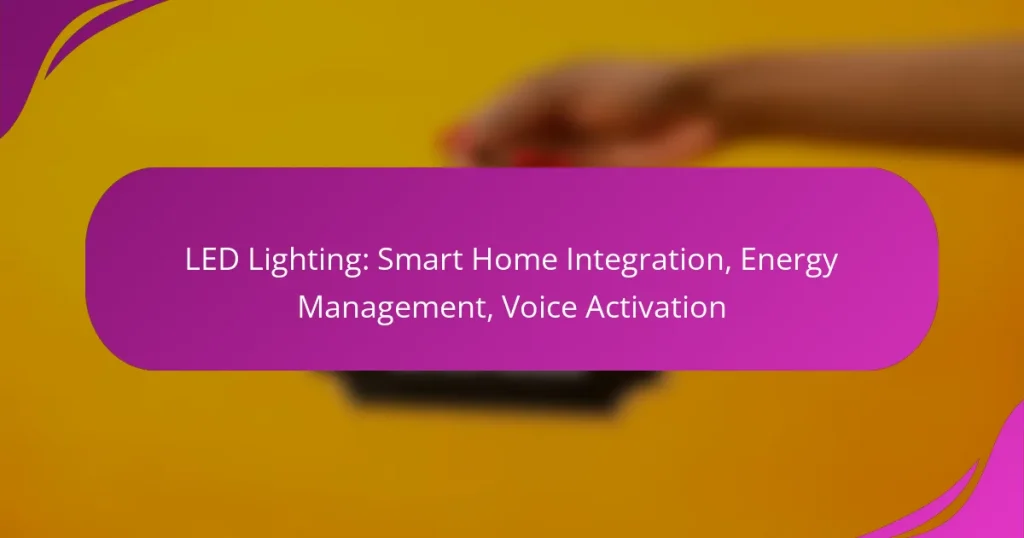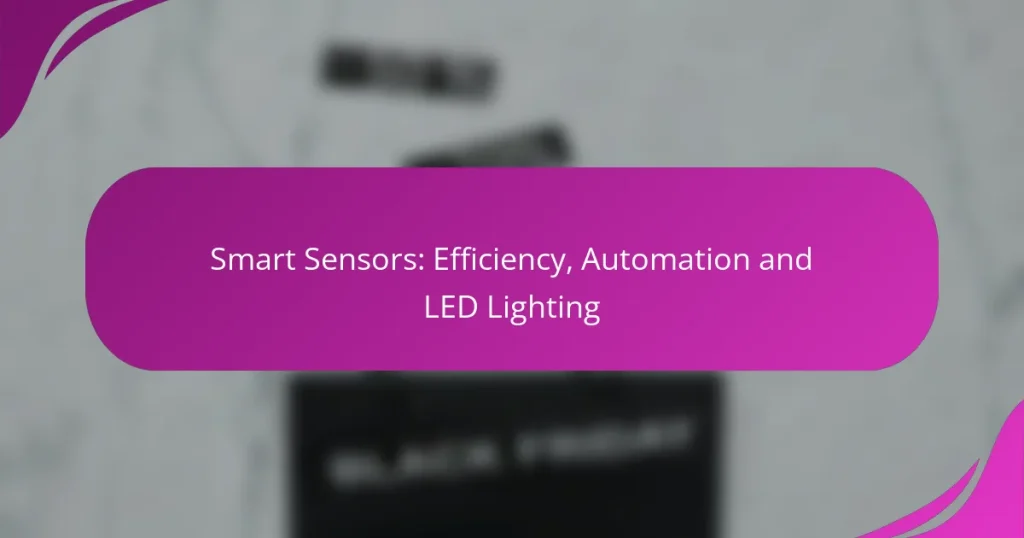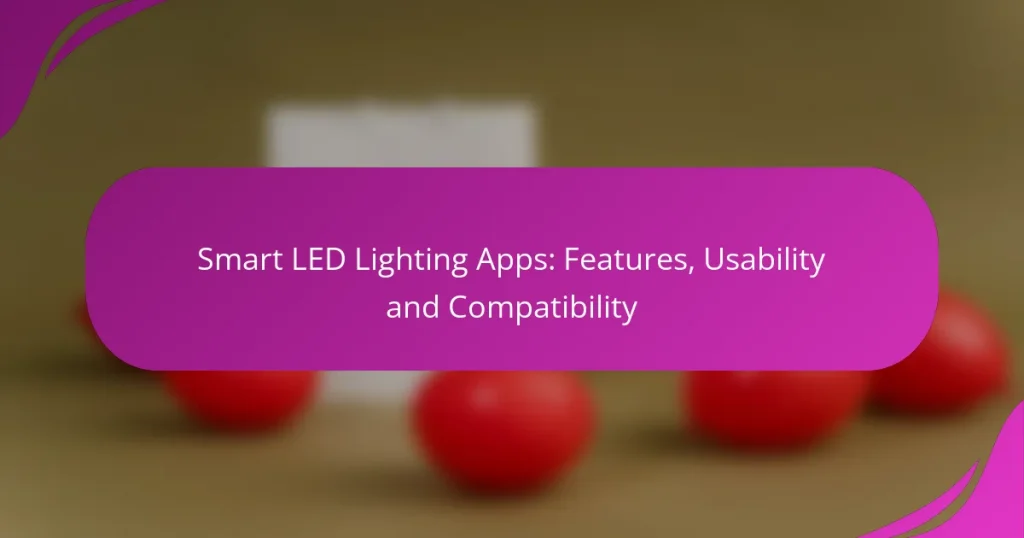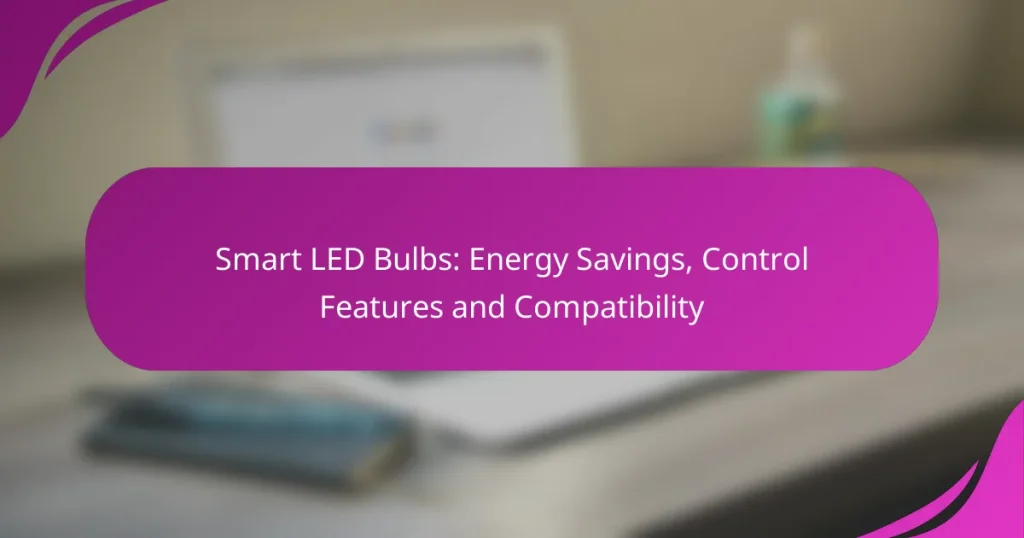LED lighting technology has evolved significantly with the integration of smart features, allowing users in the UK to control their lighting through Wi-Fi and mobile apps. This seamless connectivity enhances convenience, energy efficiency, and customization, making it easier to manage home environments. With popular products like Philips Hue and LIFX leading the market, homeowners can enjoy the benefits of automation while contributing to sustainability efforts.
Smart Sensors: Efficiency, Automation and LED Lighting
Smart LED Lighting Apps: Features, Usability and Compatibility
Smart LED Bulbs: Energy Savings, Control Features and Compatibility
LED Lighting: Voice Activation, Smart Features and User Experience
How does LED lighting integrate with smart technology in the UK?
LED lighting in the UK integrates with smart technology through Wi-Fi connectivity, compatibility with smart home systems, and mobile app control. This integration allows users to manage their lighting efficiently, enhancing convenience and energy savings.
Wi-Fi enabled LED bulbs
Wi-Fi enabled LED bulbs connect directly to your home network, allowing for remote control via smartphones or smart home devices. These bulbs typically require a simple setup process, often involving downloading an app and connecting the bulb to your Wi-Fi network.
When selecting Wi-Fi enabled bulbs, consider factors such as brightness (measured in lumens), energy efficiency ratings, and compatibility with existing smart home systems. Popular brands in the UK include Philips Hue and LIFX, which offer a range of options to suit various needs.
Smart home systems compatibility
Many LED lighting solutions are designed to work seamlessly with smart home systems like Amazon Alexa, Google Assistant, and Apple HomeKit. This compatibility allows users to control their lighting through voice commands or automated routines.
Before purchasing, check if the LED bulbs or fixtures are compatible with your existing smart home ecosystem. Some systems may require specific hubs or bridges to function correctly, so it’s essential to verify these details to avoid connectivity issues.
Mobile app control
Mobile app control is a key feature of smart LED lighting, enabling users to adjust brightness, color, and schedules from their smartphones. Most manufacturers provide dedicated apps that offer user-friendly interfaces for managing multiple lights and creating customized settings.
When using mobile apps for LED lighting, explore features like scheduling, scene creation, and energy monitoring. These functions can enhance your lighting experience and help reduce energy consumption, making it easier to manage your home’s lighting efficiently.
What are the benefits of LED smart lighting?
LED smart lighting offers numerous advantages, including enhanced energy efficiency, remote access, and the ability to customize and automate lighting settings. These features not only improve convenience but also contribute to cost savings and environmental sustainability.
Energy efficiency
LED smart lighting is significantly more energy-efficient compared to traditional lighting options. Typically, LED bulbs consume up to 80% less energy, leading to lower electricity bills and reduced carbon footprints.
When selecting LED smart lights, look for Energy Star-rated products to ensure optimal efficiency. Additionally, consider using dimmable options, which can further decrease energy usage by allowing you to adjust brightness based on your needs.
Remote access and control
One of the key benefits of LED smart lighting is the ability to control your lights remotely via smartphone apps or voice commands. This feature allows you to turn lights on or off, adjust brightness, and change colors from anywhere, enhancing convenience and security.
To maximize this benefit, ensure your smart lighting system is compatible with your home’s Wi-Fi network. This connectivity enables seamless integration with other smart home devices, creating a cohesive smart environment.
Customization and automation
LED smart lighting systems offer extensive customization options, allowing users to set schedules, create scenes, and adjust colors to match moods or activities. For example, you can program lights to gradually brighten in the morning or dim in the evening.
Automation features can be particularly useful for energy savings and security. Consider setting your lights to turn on automatically when you arrive home or to simulate occupancy while you are away. This can deter potential intruders and enhance your home’s safety.
What are the best smart LED lighting products available in the UK?
The best smart LED lighting products in the UK include Philips Hue, LIFX, and TP-Link Kasa Smart Bulbs. These options stand out for their features, compatibility, and user-friendly applications, making them ideal for enhancing home automation.
Philips Hue
Philips Hue is a leading smart lighting solution known for its extensive range of bulbs and fixtures. These products offer a variety of colors and brightness levels, allowing users to customize their lighting experience easily.
One key feature is the Hue Bridge, which connects to your Wi-Fi network, enabling control via smartphone apps or voice assistants like Amazon Alexa and Google Assistant. Philips Hue also supports routines and automation, making it a versatile choice for smart homes.
LIFX
LIFX bulbs are another popular option, distinguished by their vibrant colors and no need for a hub. They connect directly to Wi-Fi, simplifying installation and setup. Users can control LIFX lights through their app or voice commands.
These bulbs are known for their high brightness and energy efficiency, making them suitable for various settings. LIFX also offers unique features such as customizable effects and integrations with other smart home devices.
TP-Link Kasa Smart Bulbs
TP-Link Kasa Smart Bulbs provide an affordable entry point into smart lighting. They are easy to install and operate through the Kasa Smart app, which allows for scheduling, dimming, and color adjustments.
These bulbs are compatible with major voice assistants, enhancing convenience. While they may not offer as many features as Philips Hue or LIFX, they are a reliable choice for users seeking basic smart lighting functionalities without a significant investment.
How to choose the right LED smart lighting system?
Choosing the right LED smart lighting system involves assessing compatibility with your existing devices, evaluating energy consumption, and understanding installation requirements. These factors ensure that the system meets your needs and integrates smoothly into your home or office environment.
Consider compatibility with existing devices
Before selecting an LED smart lighting system, check if it is compatible with your current smart home devices, such as hubs, voice assistants, or security systems. Many systems work with popular platforms like Amazon Alexa, Google Assistant, or Apple HomeKit, which can enhance functionality.
Look for systems that support common communication protocols like Zigbee or Z-Wave, as these can offer broader compatibility. Always verify compatibility with your existing devices to avoid potential connectivity issues.
Evaluate energy consumption
Energy efficiency is a key advantage of LED smart lighting systems. Most LED bulbs consume significantly less energy than traditional incandescent or fluorescent bulbs, often reducing energy costs by 50% or more. Check the wattage and lumens output to gauge efficiency.
Consider systems that offer features like dimming or scheduling, which can further optimize energy use. Look for products with Energy Star ratings, as these meet strict efficiency guidelines and can help you save on electricity bills.
Assess installation requirements
Installation requirements can vary widely between LED smart lighting systems. Some systems are designed for easy DIY installation, while others may require professional assistance, especially if they involve complex wiring or integration with existing fixtures.
Review the installation instructions and determine if you need any additional tools or equipment. If you’re not comfortable with electrical work, hiring a qualified electrician might be a wise choice to ensure safety and compliance with local regulations.
What are the installation steps for LED smart lighting?
Installing LED smart lighting involves a few straightforward steps that ensure optimal performance and connectivity. By following these steps, you can enhance your home with energy-efficient and controllable lighting solutions.
Step 1: Choose the right location
Selecting the appropriate location for your LED smart lighting is crucial for maximizing its effectiveness. Consider areas where you spend the most time, such as living rooms, kitchens, or outdoor spaces. Ensure that the chosen spots have access to power outlets and are within range of your smart hub.
Additionally, think about the purpose of the lighting. For instance, brighter lights may be needed in workspaces, while softer lighting can create a cozy atmosphere in bedrooms. Evaluate the natural light in each area to determine the best placement for your smart bulbs.
Step 2: Install the smart bulbs
Once you have selected the locations, it’s time to install the smart bulbs. Start by turning off the power to the fixtures where you will be replacing the bulbs. Remove the existing bulbs and replace them with the smart bulbs, ensuring they are securely fitted.
After installation, turn the power back on and check that the bulbs light up. Most smart bulbs will require you to download a specific app to control them, so make sure to have your smartphone ready for the next step.
Step 3: Connect to the smart hub
The final step is to connect your smart bulbs to the smart hub or your home Wi-Fi network. Open the app associated with your smart lighting system and follow the on-screen instructions to add the new bulbs. This usually involves selecting the bulb type and connecting it to your Wi-Fi.
Ensure your smart hub is compatible with the bulbs you have purchased. If you encounter any issues, consult the manufacturer’s guidelines or troubleshooting section in the app. Once connected, you can customize settings, create schedules, and control your lighting remotely.
What are the common issues with LED smart lighting?
Common issues with LED smart lighting include connectivity problems, compatibility with existing systems, and inconsistent performance. Users often encounter difficulties with setup, integration with smart home devices, and maintaining reliable network connections.
Connectivity Issues
Connectivity issues frequently arise when LED smart lights struggle to maintain a stable connection to Wi-Fi or other networks. This can lead to delays in response times or complete disconnection from the smart home system. Ensuring a strong Wi-Fi signal and placing the smart hub centrally can mitigate these problems.
Additionally, interference from other electronic devices can disrupt connectivity. Consider using a dedicated frequency band for smart devices to minimize disruptions and improve performance.
Compatibility Challenges
Compatibility challenges occur when LED smart lighting does not work seamlessly with existing smart home systems or platforms. Before purchasing, verify that the smart lights are compatible with your current ecosystem, such as Amazon Alexa, Google Assistant, or Apple HomeKit.
Using a universal hub can help bridge compatibility gaps, allowing different brands and devices to communicate effectively. Always check for firmware updates, as manufacturers often release patches to improve compatibility.
Inconsistent Performance
Inconsistent performance in LED smart lighting can manifest as flickering, dimming, or delayed responses. These issues may stem from poor quality bulbs or inadequate power supply. Opt for reputable brands that adhere to industry standards to ensure reliability.
Regularly check the firmware of your smart lights and the controlling app to ensure optimal performance. If problems persist, consider resetting the devices or consulting customer support for troubleshooting assistance.




